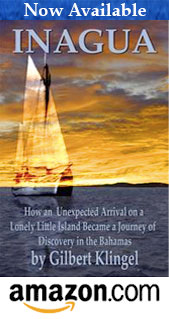Herald Tribune
November 24, 1940
Reviewed by William Beebe
INAGUA.
By Gilbert C. Klingel
SETTING out from Baltimore on the thirty-eight-foot, sailboat Basilisk, two adventurers, one who had never seen the ocean and another who had never navigated a vessel, planned an expedition to carry- out some reptilian investigations in the West Indies. With this as a start the author has written an excellent first book, I might say books, for this volume is several in one. I can think of no class of general reader who will not find a good deal in it to his taste. If he cares for physical and mental hardships and dangerous adventures, they are here in abundance; a ten-day hurricane in the tiny craft, followed by shipwreck in a calm on an unknown island, which turned out to be Inagua, the southernmost of the Bahamas. Subsequent agonies, scattered through the book, are concerned with the burning sun, knife-edged rocks, thirst, desiccating winds, mosquitoes, deadly fear of giant moray eels and sharks and drowning. How the author, who confesses to 190 pounds, could have survived all this and more is a tribute to almost superhuman resistance.
In spite of all, good luck attended the two men, for their scientific equipment enjoyed a regular Robinson Crusoe immunity, and camera, microscope, guns and “rusty typewriter” were got into working order after a period of terrific knocking about and of salt-water immersion. After settling down in a deserted, thatched cottage Mr. Coleman, the author’s companion, had to return north. Klingel remained for six months and made the cottage headquarters for observation of the wild life of the island, of its geological genesis and for reflections on problems suggested by the habits of various organisms. This is the raison d’etre of the book and should have made a classic both for the interested layman and the scientifically minded naturalist.
Scattered through all this portion, like raisins in a bun, are hints of the extraordinarily interesting interrelationships of the insular fauna. But they are hidden in a mass of personalities and of zoological generalities, a writing down to the average reader which dilutes and vitiates the solid core. Here again there will be many persons who prefer the author’s adventures with his donkey and the detailed list of the songs he whistled en route to the cave of the bats. But the succeeding two-thirds of the account of this particular trip, dealing with the bats themselves, is much of it real meat and every fact concerning the Inaguan bats, but not bats in general is of vital concern to any interested reader.
If the three hundred and eighty odd pages could be reduced by one third; the various organisms studied and presented more thoroughly, or a single individual lizard, crab or bat made to materialize on the printed page, Inagua would have taken its place with Darwin’s Galapagos, Fabre’s Midi and Hudson’s pampas.
There are passages of exceedingly good, impersonal writing, which are worth reading and rereading. But again and again we are led with keen interest up to some creature or situation only to be blocked by digression, either personal or factual. I found myself constantly saying. “Go on, go on, what did it do then?”
By far the best writing in the book and the height of dramatic interest is the experience in Mathewtown, the down-at-heel, Negro-governed settlement, and the delineation of its various amazing characters. The illustrations are good and appropriate, we are glad to have the end-paper map, but the total lack of an index still further buries the valuable portions in the depths of the volume. With all these reservations, however, the book is well worth buying and reading.



